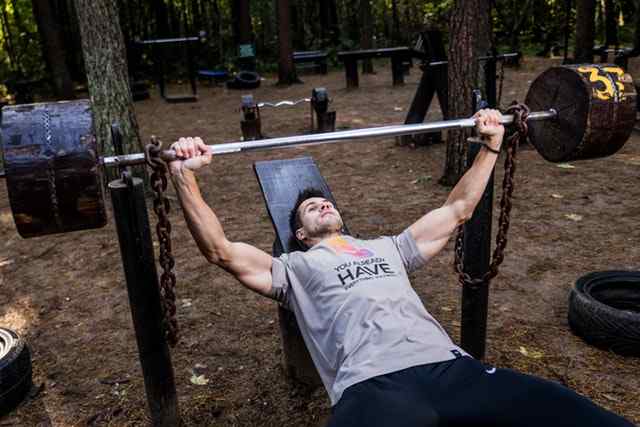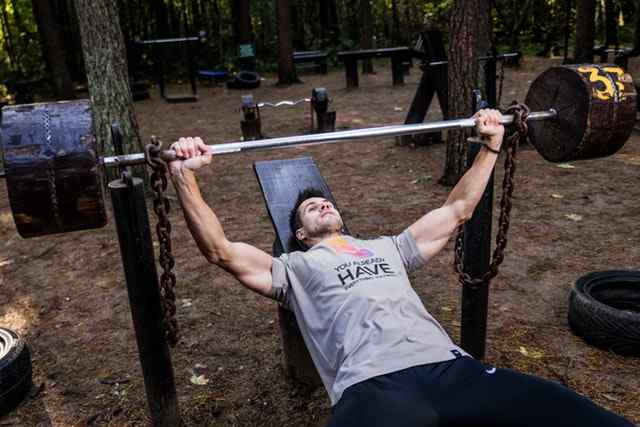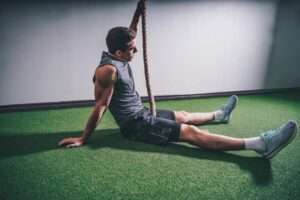Chest is a major muscle involve different regions of the pectoralis major. You have the upper chest – which is known as the “clavicular” site – and you have the middle and lower fibers – which are known as the “sternal site”.
The upper portion of the chest is best targeted when performing the exercises at an incline of at least 30 degrees. If you’ve ever tried any incline pressing movements, I’m sure you’ve noticed that you can’t lift as much at an incline as you can when performing chest press movements on a flat or decline bench.
The reason for that is because the upper chest (aka. clavicular site) is a lot smaller and weaker than the sternal site (middle and lower fibers). While the upper aspect of the chest is best targeted via incline pressing movements, the middle and lower aspect of the chest is best targeted via flat and decline pressing movements.
The lower part of your chest can also be targeted with dips. So, just to give you a guideline, some good exercises for the upper chest are incline presses and incline flies. For the middle aspect of the chest, go with the barbell bench press – or any flat pressing or fly movement for that matter. And for the lower aspect of your chest, you can do decline presses and dips. Of course, there’s an entire chest exercise database to the right of this article so you have plenty of options.
Pectoralis Minor & Serratus Anterior
Both of these muscles share the similar function of protracting the shoulder blades (scapula) forward. What does “protracting” the shoulders forward mean? Well, it’s not that complicated. Extend your arms straight out in front of you. Now, try to push them forward while keeping them straight. In order to do so, your shoulders will have to be drawn forward. When that happens, your scapula (bones in your upper back) will be drawn apart (protracted).
The pectoralis minor & serratus anterior commonly work together as a unit because in addition to protracting the shoulder blades forward, they assist each other in many other movements as well. For example, the pectoralis minor assists the serratus anterior to draw the shoulder blades downwards when performing chin ups.
Not that this is over-exciting but a lot of people tend to have a weak serratus anterior. The weakness is easily identified though. Just extend your arm straight forward and if your shoulder blade “wings out”, your serratus anterior is weak.
Easily identified and easily corrected. If the “winging” occurs, you just need to perform a modified version of the push up exercise. Get yourself in the starting position for a push up (arms straight, torso aligned etc) and rather than lowering yourself down to the ground, you’re going to push upwards instead.
Remember that scapula protraction movement discussed above? You basically want to do that while in a push up position. Now, I know what you’re thinking. You’re thinking “who cares”, “I didn’t even know what my “serratus anterior” was until about 15 seconds ago”.
Well, it’s actually pretty important that you correct all your weaknesses because as the old saying goes – you’re only as strong as your weakest link. In this case, the saying holds true because a weak serratus anterior can hinder your bench press strength. A winging of your shoulder blade may also be an indicator of a shortened pectoralis minor. In which case, you’d have to work on your chest flexibility a little more.
Chest Training
When training the chest – or almost any body part for that matter – it’s always best to begin your workout with compound movements. Compound movements are multi-joint exercises that work multiple muscle groups. A good example of a “compound” exercise for the chest would be the barbell bench press.
There seems to be a lot of confusion when it comes to the ideal grip and hand placement when performing pressing movements. While this is all covered in detail in the barbell bench press exercise description, we might as well touch on it here as well.
The overall safest grip has been shown to be at a position where the wrists are directly lined up with the elbow when the arms reach a 90 degree angle. Also important to note is that the wrists are to be kept in a straight locked position at all times. Allowing the hands to be forced from a neutral position places unnecessary stress on the joint.
Here’s an animated shot of what I’m talking about. You’ll see that the arms are bent at a 90 degree angle, the bar is brought down to the mid-point of the chest and last but not least – the wrists and elbows are directly aligned.
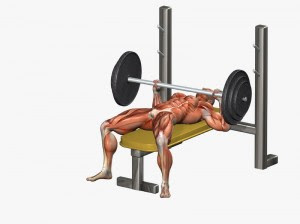 |
| Bodybuilding set |
Although the above illustration depicts the overall safest way of performing the movement, using alternate methods have their positives and negatives. Below is a chart contrasting the differences between a wide grip and a narrow grip in comparison to the above method.
In addition to the grip variations, the angle of the arms also plays an important role on the muscle recruitment. Performing the bench press with the upper arm angled at 90 degrees to the body draws optimal recruitment from the pectorals. However, the potential downside to this method is the increased stress placed on the shoulder joint.
An effective method to decrease the stress on the shoulder joint would be to position your arm at a 45 degree angle to the body. This is easier on the shoulder but slightly decreases the amount of pectoral involvement. Both of the above styles are effective provided that they are used within the appropriate program stages.
The photo below illustrates the hand arm position for the bodybuilding method. Note that the elbows and shoulders are in alignment. The bar is typically lowered to the upper chest region when utilizing this style. Recall that this method is harder on the shoulder joints so many trainees have a difficult time bringing the bar all the way down to the chest.
For the “powerlifting” method – which is actually safe/suitable for almost everyone – the arms are brought down at an angle below shoulder level. Click here to be redirected to the bench press demonstration. Watch the video and you’ll notice the lifter in is bringing the bar to the lower part of his chest. Doing so alleviates the stress on the shoulders. This is perhaps the safest method of performing the exercise.
Muscle recruitment also varies depending on the stage of movement. If we broke the bench press movement down into three stages, we would find that different muscles are called into play throughout the motion.
Stage 1: This stage refers to the stage that has you pressing the bar off of the chest. When this occurs, there is a sudden burst of activity throughout all muscles involved in the pressing movement (pectorals, triceps and anterior deltoid).
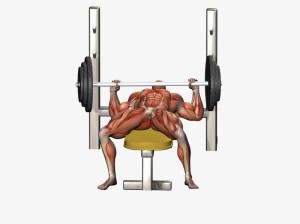 |
|
Phase 1: Initial Push
|
 |
|
Phase 2: The Midpoint
|
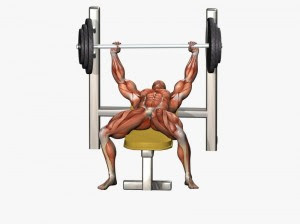 |
|
Phase 3: The Lockout
|
Knowing that the pectorals are most active during the first 2 to 3 of the movement, we can use this information to develop a modified version to maximize chest recruitment. This modified version of the bench press would have you completing only the movements involved in stage 2. Avoiding lock-out at the finish removes the stage where the chest would typically get a rest.
Removing the rest will increase the difficulty of the movement & increasing the difficulty often allows for greater results. It should be noted that performing this modified version has its disadvantages and should be used as an occasional addition, rather then a permanent replacement to the regular full motion movement.
I’m sure you’ve already noticed how a lot of guys – you know the type – do nothing but bench press and bicep curls while completely neglecting to train their other body parts. After all, girls like pecs & pipes (chest and arms) so that’s where the guys place their focus.
When this happens, both postural and functional complications arise and corrective measures must be taken to avoid injury. Over-training – along with a lack of flexibility – causes the shoulders to rotate internally as the pectorals tighten up (shorten).
A simple way to check for this disorder is to evaluate your casual standing position. Your regular stance should have your arms hang to the sides with the palms in a neutral position. If the pectorals are tight, the palms will be turned in the direction of your front thigh.
To correct and avoid potential injuries associated with over-training, it is recommended that you train chest no more frequently then your other body parts. Also, stretching is essential for the recovery process and ensures that your muscles will return to resting length.
In addition, muscle balance is key considering that our body works together as one kinetic chain. Performing external rotation exercises following your chest program is a great way to prevent imbalances and strengthen some of the opposing muscles in the posterior rotator cuff.
5 Easy Steps To Get Bigger Chest At Home
Push up exercise
Back to the basics! The pushup exercise, although simplistic, is one of the fundamental movements for upper body development. Commonly performed in gym classes and training camps throughout the world, the pushup exercise has become somewhat of a staple exercise amongst the fitness community.
Since push ups are classed as a compound movement and can be done anywhere, performing them in attempt to target the chest, triceps, anterior deltoids and the entire core region becomes a practical alternative for those who, for whatever reason, can’t make it to the gym.
All factors considered, the convenience of not needing equipment in combination with the progressions available to accommodate a variety of skill levels, make the pushups exercise a must for almost every training program
Incline Dumbbell Press
The purpose of performing incline dumbbell presses is to target the upper region of the chest. Incline dumbbell presses are actually one of the best chest building exercises that you can do. Ideally, you want to set the bench to a 30 degree angle. If the bench is angled too high, an increased reliance will be placed upon the front portion of the shoulder with less recruitment from the upper chest – which is the area you’re trying to target.
Incline dumbbell presses are very similar to performing a barbell press except working with free weights gives you more freedom in regards to the range of motion. Since each arm is independently responsible for its own workload, more stabilizing muscles are recruited for assistance. This increased need for stabilization will develop functional strength, which can easily be carried over to athletics and daily activities.
Parallel bar dips
Overall, the dips exercise trains the front of the shoulder, the chest and the triceps. However, the muscle recruitment depends on the technique used to perform the repetitions. If the trainee leans forward while performing the dips exercise, maximal activation occurs at the chest.
If you were to maintain an upright posture while performing the dips exercise, maximal recruitment is drawn from the triceps. It is important to note that if you’re performing parallel bar dips with an upright posture (the triceps version), then the range of motion should be limited to reduce the risk of sustaining a shoulder injury.
Plyometric push ups
This is a rather advanced exercise designed to develop explosive power. I use this particular movement to work on hand-speed for martial arts however, it’s a very beneficial for a variety of sports. For example, lineman in football who have to explosively drive past their opponent and rush the quarterback.
Prior to performing this exercise, you should reach a minimum fitness requirement of being able to bench press your own body weight for 8-to-10 repetitions.
Dumbbell flies
Dumbbell flies are a great movement to sculpt the chest. You can perform dumbbell flies from a variety of angles – each of which will target a different region of the chest. I recommend that you review our chest training article for more information on which angle targets which region of the chest and also, for some great tips regarding how to effectively incorporate dumbbell flies into super sets.
It’s unfortunate that dumbbell flies – being as effective as they are – commonly get performed incorrectly. People tend to make the mistake of allowing their shoulders to drift into an externally rotated position. When this happens, it changes the line of pull of the chest and also places unnecessary stress on the elbow joints.
To keep it simple, just remember that when you’re performing dumbbell flies, your elbows should always be facing the ground.
I hope these exercises help you build your chest muscle fast, also for more information visit our blog vikas fitness guide

